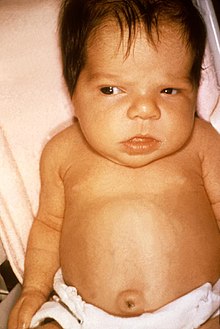
Back يرقان وليدي Arabic یئنیدوْغان ساریلیغی AZB Novorozenecká žloutenka Czech Neugeborenengelbsucht German Νεογνικός ίκτερος Greek Ictericia del recién nacido Spanish Neonataalne hüperbilirubineemia Estonian زردی نوزادان Persian नवजात शिशुओं में पीलिया Hindi Նորածինների դեղնախտ Armenian
| Neonatal jaundice | |
|---|---|
| Other names | Neonatal hyperbilirubinemia, neonatal icterus, jaundice in newborns |
 | |
| Jaundice in a newborn | |
| Specialty | Pediatrics |
| Symptoms | Yellowish discoloration of the skin and white part of the eyes[1] |
| Complications | Seizures, cerebral palsy, kernicterus[1] |
| Usual onset | Newborns[1] |
| Types | Physiologic, pathologic[1] |
| Causes | Red blood cell breakdown, liver disease, infection, hypothyroidism, metabolic disorders[2][1] |
| Diagnostic method | Based on symptoms, confirmed by bilirubin[1] |
| Treatment | More frequent feeding, phototherapy, exchange transfusions[1] |
| Frequency | >50% of babies[1] |
Neonatal jaundice is a yellowish discoloration of the white part of the eyes and skin in a newborn baby due to high bilirubin levels.[1] Other symptoms may include excess sleepiness or poor feeding.[1] Complications may include seizures, cerebral palsy, or kernicterus.[1]
In most of cases there is no specific underlying physiologic disorder.[2] In other cases it results from red blood cell breakdown, liver disease, infection, hypothyroidism, or metabolic disorders (pathologic).[2][1] A bilirubin level more than 34 μmol/L (2 mg/dL) may be visible.[1] Concerns, in otherwise healthy babies, occur when levels are greater than 308 μmol/L (18 mg/dL), jaundice is noticed in the first day of life, there is a rapid rise in levels, jaundice lasts more than two weeks, or the baby appears unwell.[1] In those with concerning findings further investigations to determine the underlying cause are recommended.[1]
The need for treatment depends on bilirubin levels, the age of the child, and the underlying cause.[1][3] Treatments may include more frequent feeding, phototherapy, or exchange transfusions.[1] In those who are born early more aggressive treatment tends to be required.[1] Physiologic jaundice generally lasts less than seven days.[1] The condition affects over half of babies in the first week of life.[1] Of babies that are born early about 80% are affected.[2] Globally over 100,000 late-preterm and term babies die each year as a result of jaundice.[4]
- ^ a b c d e f g h i j k l m n o p q r s t "Neonatal Hyperbilirubinemia". Merck Manuals Professional Edition. August 2015. Retrieved 11 December 2017.
- ^ a b c d "Jaundice in newborn babies under 28 days | Guidance and guidelines". NICE. October 2016. Retrieved 11 December 2017.
- ^ "Jaundice in newborn babies under 28 days". NICE. October 2016. Retrieved 11 December 2017.
- ^ Olusanya, BO; Teeple, S; Kassebaum, NJ (February 2018). "The Contribution of Neonatal Jaundice to Global Child Mortality: Findings From the GBD 2016 Study". Pediatrics. 141 (2): e20171471. doi:10.1542/peds.2017-1471. PMID 29305393.